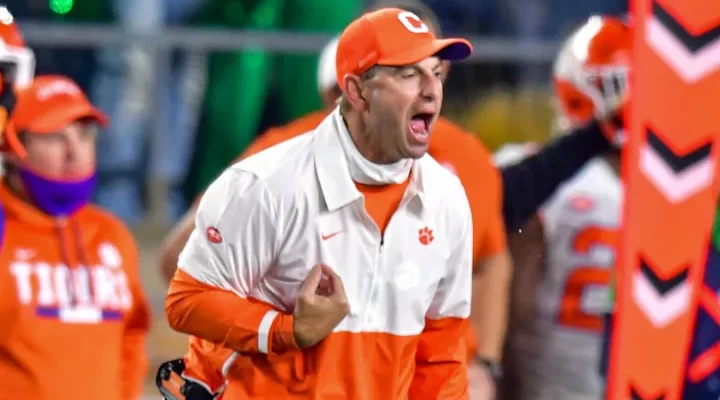BREAKING NEWS: Clemson Loses Key Recruiting Battle as Star DE Bryce Perry-Wright Commits to Texas A&M
In what is shaping up to be one of the more surprising recruiting twists of the 2025 cycle, highly touted defensive end Bryce Perry-Wright has committed to Texas A&M, turning down offers from several national powers—including the Clemson Tigers. At 6-foot-3 and 260 pounds, Perry-Wright is considered one of the most explosive edge rushers in the country, and his decision to choose the Aggies over Clemson has sent shockwaves across the college football landscape. While recruiting losses happen every year, this one cuts deep for the Tigers, not just because of the player’s immense talent, but because of what it signals about the evolving recruiting dynamics in college football’s new era.
Perry-Wright had long been viewed as a strong Clemson lean. He made multiple visits to campus, had a great rapport with the Tigers’ coaching staff, and publicly praised Clemson’s defensive legacy. Many insiders believed it was only a matter of time before he gave his verbal commitment to Dabo Swinney’s program. Yet, in the final stretch, Texas A&M made a late surge—and whatever they pitched, promised, or packaged, it worked. Despite Clemson’s best efforts, Perry-Wright was swayed, and now the prized pass rusher will be donning maroon and white, not orange and purple.
This recruiting loss doesn’t just sting because of Perry-Wright’s ranking, although that alone makes it significant. He is a consensus top-50 prospect in the 2025 class, with some outlets ranking him as high as the No. 2 defensive end in the nation. His combination of power, agility, and explosiveness off the edge made him a dream fit for Clemson’s attacking defensive scheme. The Tigers envisioned him as a cornerstone piece in their future front seven, potentially filling the shoes of past greats like Clelin Ferrell, Myles Murphy, or Xavier Thomas. Instead, Clemson now finds itself regrouping while a top rival in the SEC secures a major win on the recruiting trail.
The reality is that college football recruiting is no longer just about tradition, playing time, or campus visits. The arrival of Name, Image, and Likeness (NIL) compensation has added an entirely new dimension to the process. Schools with deep financial backing, structured NIL collectives, and aggressive recruiting strategies are now outbidding historically dominant programs for elite talent. And whether directly acknowledged or not, NIL likely played a major role in Perry-Wright’s final decision.
Sources close to the situation suggest that Texas A&M’s NIL infrastructure played a decisive part in turning the tide. The Aggies have been one of the most aggressive programs in the country when it comes to leveraging NIL opportunities for top recruits, and Perry-Wright’s commitment seems to underscore their continued success in this space. While Clemson remains competitive on the field, their approach to NIL has been more conservative, with Dabo Swinney publicly stating he wants to protect the core values of college athletics. That philosophy, while admirable in some eyes, may have cost Clemson in this particular case.
For Clemson, the loss of Perry-Wright creates more than just a roster gap. It reignites a broader discussion about how the program is adapting—or not adapting—to the modern realities of college football. Recruiting has always been the lifeblood of national championship contenders, and in today’s game, elite programs must balance tradition with innovation. Swinney and his staff continue to emphasize culture, development, and a family-first approach. But as more and more recruits gravitate toward schools offering immediate compensation, high-visibility branding, and NIL security, that model faces growing challenges.
This isn’t to say that Clemson is falling off a cliff or incapable of landing top-tier players. Far from it. The Tigers still boast one of the most talented rosters in the country and have already secured several key commitments in the 2025 class. But missing on a player like Perry-Wright, especially when he seemed to be within reach for months, is a blow that underscores the shifting sands of the recruiting world. It’s a sign that even programs with championship banners and NFL pipelines must fight harder than ever to keep pace.
The timing of this decision also adds to the sting. With fall camp approaching, the Tigers had hoped to solidify their defensive line future early and avoid late-cycle scrambling. Now, with Perry-Wright off the board, the coaching staff must pivot quickly. There are still quality defensive ends available, but few with the upside, frame, and production Perry-Wright brings. Clemson will likely have to evaluate whether to push harder for second-tier prospects or wait for potential flips and decommitments later in the cycle.
Beyond just depth chart implications, there’s a recruiting optics component to consider. Momentum in recruiting often builds or erodes based on key decisions. Landing a blue-chip defensive end like Perry-Wright could have sparked additional commitments and raised the program’s profile with other top targets. Conversely, missing out sends a message—fair or not—that Clemson may be vulnerable to late pushes from NIL-heavy programs. For a coaching staff that prides itself on closing strong, this particular loss hits in multiple ways.
Perry-Wright, for his part, has handled the process with professionalism and poise. In his commitment announcement, he thanked Clemson coaches for their efforts and said he had nothing but respect for the program. He cited “opportunity, alignment with future goals, and overall support system” as reasons for choosing Texas A&M. Whether those words reflect NIL realities or not, they confirm that the Aggies offered something Clemson couldn’t or wouldn’t match at this time.
Looking ahead, Clemson fans and insiders will watch closely to see how the Tigers respond. Recruiting losses can’t be avoided, but how a program rebounds from them often reveals its strength. Will Clemson adapt its NIL approach to better compete with the power players of the SEC and Big Ten? Will Dabo Swinney adjust his messaging or structure to meet recruits where they are in 2025 and beyond? These are the kinds of strategic questions that now loom large.
In the meantime, Texas A&M celebrates a major win. Under head coach Mike Elko, the Aggies are clearly focused on making a national splash—not just on Saturdays, but on the recruiting trail as well. Adding Perry-Wright to their future defensive plans sends a message to the rest of the country: Texas A&M is serious about building a contender, and they’re willing to do what it takes to bring in elite talent. For a program that has flirted with greatness but lacked consistent postseason success, stacking classes with players like Perry-Wright is the necessary next step.
As for Clemson, the loss may feel like a gut punch today, but it doesn’t have to define the class or derail the season. Dabo Swinney has built one of the most consistent programs in college football over the last decade, and one recruiting miss—however painful—isn’t the end of the road. The Tigers will likely circle back to evaluate existing targets, re-energize relationships, and possibly look at the transfer portal as a longer-term play to replenish the defensive line.
Still, Perry-Wright’s decision is more than just one name on one commitment list. It’s a reminder that in the new college football landscape, everything is fluid, and nothing is guaranteed. Even a presumed lock can change course in the final hour. Even a program with national titles can lose a recruiting battle when NIL, opportunity, and momentum align somewhere else.
This one will sting for a while in Tiger Town. But if there’s any silver lining, it’s the wake-up call it provides. In a rapidly changing sport, staying still—even when successful—is not an option. Clemson must now look inward, reassess its approach, and ask the difficult questions about what it will take to win not just games, but the ever-evolving game of recruiting in the NIL era.


